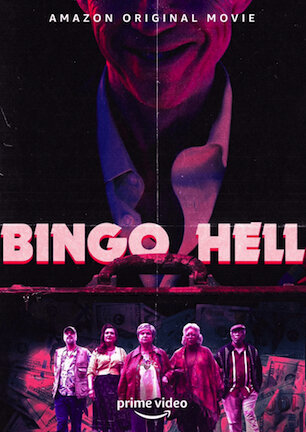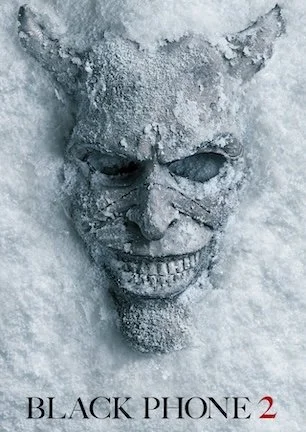Studio: Blumhouse/Amazon Studios
Director: Gigi Saul Guerrero
Writer: Shane McKenzie, Gigi Saul Guerrero, Perry Blackshear
Producer: Ian Watermeier
Stars: Adriana Barraza, L. Scott Caldwell, Joshua Caleb Johnson, Richard Brake, Clayton Landey, Jonathan Medina, Bertila Damas, Grover Cleveland Coulson, David Jensen, Kelly Murtagh
Review Score:
Summary:
Senior citizens band together to stop a mysterious man whose supernatural bingo hall threatens to destroy their small town.
Review:
There’s a certain segment of horror film fans who can’t say the name “Blumhouse” without spitting in disgust immediately after. They’re the ones who stubbornly insist Jason Blum hasn’t produced a single worthwhile movie, and hilariously claim his brand has been nothing but bad for the genre.
This is neither the time nor the space to get into a full-blown debate over Blumhouse. I’ll simply say I suspect the hate stems from that age-old inability to enjoy anything perceived as too popular or too mainstream. “Oh, Entertainment Weekly loved it and it grossed 100 million dollars? Well then I automatically despise it!” The reality is, Blumhouse is the #1 name in horror and only getting bigger. You don’t have to like it, but you’d better get used to it.
On the whole, I enjoy Blumhouse’s output. They’re producing far fewer pieces of pap nowadays, and when they do, it’s usually easy to tell which are the safe-to-avoid “lesser” titles on their distribution slate. You used to know by the secondary ‘Blumhouse Tilt’ banner, but I think they stopped using it once viewers caught on that ‘BH Tilt’ was code for a bargain budget DTV’er. Now you can figure out which ones are their negligible six-figure pickups and which ones were professionally stewarded from script to screen based on cast lists, what gets a TV ad campaign, what debuts on which streaming platform, etc.
Which brings us to ‘Welcome to the Blumhouse,’ a makeshift “event” where four original movies are released on Amazon Prime over two consecutive Fridays in October.
I wasn’t sure I wanted to cover the second year of ‘Welcome to the Blumhouse’ because frankly, no one seemed to care the first time around. Proving my point about how invisible these flicks became, what’s funny is I reviewed three of the four ‘Welcome to the Blumhouse’ movies in 2020 and, I sh*t you not, right now the only title I can think of off the top of my head is the one film I didn’t watch. All four features were swept away in the tsunami of Halloween season releases, leaving ‘Welcome to the Blumhouse’ to look like a half-hearted attempt at marketing unrelated productions they weren’t sure what to do with.
To mitigate my risk of writing more content no one would click on once the calendar changed to November, for 2021 I decided to review just one of the two features each week. Week one meant choosing between “Black as Night” and “Bingo Hell.”
“Black as Night’s” summary said, “A resourceful teenage girl leaves childhood behind when she battles a group of deadly vampires in an action-horror hybrid with a strong social conscience and biting sense of humor.” This reminded me of the excellent and underappreciated “Vampires vs. the Bronx” (review here), so I felt like I’d already seen a great take on similar themes. While never a dealbreaker by itself, “Black as Night” also didn’t have any names I knew in its cast or crew. Add in a few pretty plain promotional stills and I sensed this was one movie that wouldn’t attract much attention.
That almost made me go with “Black as Night,” because I figured I’d be one of the few voices talking about it and it had the best chance of surprising me. Meanwhile, “Bingo Hell” looked to lean even heavier on its laughter component, and pure horror-comedies are rarely my bag. Its summary said, “When a sinister figure threatens the residents of a low-income community, a feisty senior citizen tries to stop him in a wickedly original horror movie with a fiendishly funny twist.” Not necessarily tailor made for my tastes.
But “Bingo Hell” came from director Gigi Saul Guerrero, a name I recognize from the L.A. horror community as well as from her previous work, including as a commercial actress. Then I saw one of the writers was Perry Blackshear, whose outstanding thrillers “They Look Like People” (review here) and “When I Consume You” (review here) are among the best minimalist movies made in the past decade. Of the two options, “Bingo Hell” edged out “Black as Night” as the one with the most hope of having lasting legs for one reason or another, so that’s what I went with.
Until or unless I watch “Black as Night,” I won’t know if I made the better choice. What I do know is I picked something that’s definitely in line with ‘Welcome to the Blumhouse’s’ telltale flavor: a lower-tier indie that shows some shagginess, still hits a few high notes, and ultimately falls into that midrange of “it’s okay,” which is not-so-coincidentally the recipe for how these films eventually find themselves lost in the shuffle.
Oak Springs is the kind of small town that only bustles this busily in the movies. While neighborhood mainstay Lupita makes her way from her home to the bingo hall, she passes plenty of people putting up signs, greeting her warmly, pulling books out of a free library, and grabbing drinks from a gentrified coffee shop. The only thing missing is an apron-wearing shopkeeper sweeping the sidewalk. Or a 2nd A.D. to say, “Hey, do you think maybe there’s *too* much going on in the background? We have enough extras to pack a small stadium.” Times Square doesn’t have as much activity as this dying little community.
“Bingo Hell” doesn’t look its best in these scenes for a different reason though. Exteriors are almost as ugly as they can get, with washed out flatness devoid of any shadows to accentuate actors. The camera and lighting crew could use a crash course in netting to knock down exposures. Every time a door opens, it’s like looking straight into the sun. I expect this blown-out look from point-and-shoot VOD cheapies, but even Blumhouse’s B-sides should be able to do better than this.
Everything improves once “Bingo Hell” moves indoors, which is where most of the movie takes place anyway. Although, you do have to meet the restricted production budget halfway to accept a small room dressed up in tinsel and disco lights as a gaudy gambling hall. But this is a small town, and “Bingo Hell” flirts with an intentional hint of supernatural absurdity, so we can let some limitations slide.
Besides, “Bingo Hell’s” strength is in the charming performances behind its charismatic characters. Since I already took enough time talking about ‘Welcome to the Blumhouse’ instead of this specific movie, I’ll single out L. Scott Caldwell as Lupita’s wizened best friend Dolores. Caldwell is fantastically endearing as a seen-it-all grandmother who can cut through bullsh*t with a single mmm-hmm glare. Combined with the other mildly quirky old coots in Oak Springs, I started wanting to see a straight drama about their everyday lives devoid of any ectoplasm, eeriness, or otherworldly evil.
Adjusting expectations for the hybrid style “Bingo Hell” has is key to getting into the film. Intensity briefly amps up during three quick kill scenes, but the horror otherwise isn’t all that heavy. Neither is the humor, though that’s partially by design. “Bingo Hell’s” tone means to be more mildly odd than laugh-out-loud loony, so no one should expect endless one-liners either.
Plot progression gets a bit clumsy in the last act. By that I mean, prominent people who had significant screen time in the beginning fade indistinctly into nonentities. Meanwhile, secondary players suddenly jump to the forefront of major moments. I have a hunch maybe a runtime mandate, editing room excisions, or having at least three hands in the screenplay had something to do with the narrative’s noticeable nips and tucks.
That’s how we arrive at “uneven” as a fair descriptor for the film. “Bingo Hell” brings out some smiles, some squirms, some sentimental sweetness, and some room temperature thrills. It’s basically what we’ve come to expect from the ‘Welcome to the Blumhouse’ label, i.e. some good and some bad, with the good being a night’s worth of okay entertainment, and the bad being something not likely to stick with you after the weekend.
Review Score: 65






Compelling performances keep “Hallow Road” swimming as strongly as possible against the strong current of a drowsy pace.